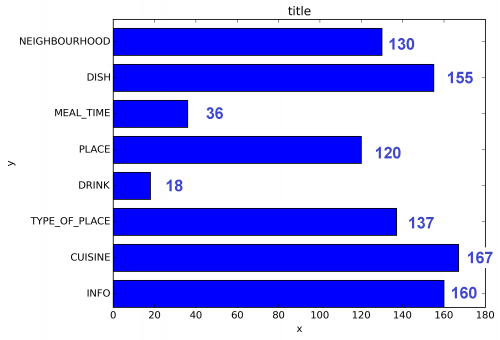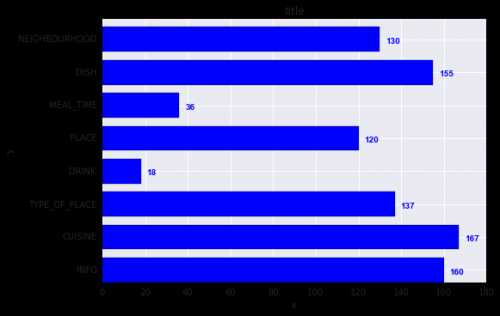Jak wyświetlić wartość paska na każdym pasku za pomocą pyplot.barh()?
Wygenerowałem Wykres słupka, Jak mogę wyświetlić wartość słupka na każdym słupku?
Aktualny wykres:

Co staram się zdobyć:

Mój kod:
import os
import numpy as np
import matplotlib.pyplot as plt
x = [u'INFO', u'CUISINE', u'TYPE_OF_PLACE', u'DRINK', u'PLACE', u'MEAL_TIME', u'DISH', u'NEIGHBOURHOOD']
y = [160, 167, 137, 18, 120, 36, 155, 130]
fig, ax = plt.subplots()
width = 0.75 # the width of the bars
ind = np.arange(len(y)) # the x locations for the groups
ax.barh(ind, y, width, color="blue")
ax.set_yticks(ind+width/2)
ax.set_yticklabels(x, minor=False)
plt.title('title')
plt.xlabel('x')
plt.ylabel('y')
#plt.show()
plt.savefig(os.path.join('test.png'), dpi=300, format='png', bbox_inches='tight') # use format='svg' or 'pdf' for vectorial pictures
3 answers
Dodaj:
for i, v in enumerate(y):
ax.text(v + 3, i + .25, str(v), color='blue', fontweight='bold')
Wynik:

Wartości y v są zarówno lokalizacją x, jak i wartościami ciągu znaków dla ax.text, A wygodnie słupek ma metrykę 1 dla każdego słupka, więc wyliczenie i jest lokalizacją y.
Warning: date(): Invalid date.timezone value 'Europe/Kyiv', we selected the timezone 'UTC' for now. in /var/www/agent_stack/data/www/doraprojects.net/template/agent.layouts/content.php on line 54
2017-05-23 18:30:30
Zauważyłem Kod przykładowego api zawiera przykład barcharta z wartością paska wyświetlaną na każdym pasku:
"""
========
Barchart
========
A bar plot with errorbars and height labels on individual bars
"""
import numpy as np
import matplotlib.pyplot as plt
N = 5
men_means = (20, 35, 30, 35, 27)
men_std = (2, 3, 4, 1, 2)
ind = np.arange(N) # the x locations for the groups
width = 0.35 # the width of the bars
fig, ax = plt.subplots()
rects1 = ax.bar(ind, men_means, width, color='r', yerr=men_std)
women_means = (25, 32, 34, 20, 25)
women_std = (3, 5, 2, 3, 3)
rects2 = ax.bar(ind + width, women_means, width, color='y', yerr=women_std)
# add some text for labels, title and axes ticks
ax.set_ylabel('Scores')
ax.set_title('Scores by group and gender')
ax.set_xticks(ind + width / 2)
ax.set_xticklabels(('G1', 'G2', 'G3', 'G4', 'G5'))
ax.legend((rects1[0], rects2[0]), ('Men', 'Women'))
def autolabel(rects):
"""
Attach a text label above each bar displaying its height
"""
for rect in rects:
height = rect.get_height()
ax.text(rect.get_x() + rect.get_width()/2., 1.05*height,
'%d' % int(height),
ha='center', va='bottom')
autolabel(rects1)
autolabel(rects2)
plt.show()
Wyjście:
FYI Jaka jest jednostka zmiennej wysokości w" barh " matplotlib? (Obecnie nie ma łatwego sposobu na ustawienie stałej wysokości dla każdego paska)
Warning: date(): Invalid date.timezone value 'Europe/Kyiv', we selected the timezone 'UTC' for now. in /var/www/agent_stack/data/www/doraprojects.net/template/agent.layouts/content.php on line 54
2017-05-23 12:34:53
Wiem, że to stary wątek, ale trafiłem tu kilka razy przez Google i uważam, że żadna udzielona odpowiedź nie jest jeszcze satysfakcjonująca. Spróbuj użyć jednej z następujących funkcji:
def label_bar(ax, bars, text_format, is_inside=True, **kwargs):
"""
Attach a text label to each bar displaying its y value
"""
max_y_value = max(bar.get_height() for bar in bars)
if is_inside:
distance = max_y_value * 0.05
else:
distance = max_y_value * 0.01
for bar in bars:
text = text_format.format(bar.get_height())
text_x = bar.get_x() + bar.get_width() / 2
if is_inside:
text_y = bar.get_height() - distance
else:
text_y = bar.get_height() + distance
ax.text(text_x, text_y, text, ha='center', va='bottom', **kwargs)
def label_barh(ax, bars, text_format, is_inside=True, **kwargs):
"""
Attach a text label to each horizontal bar displaying its y value
"""
max_y_value = max(bar.get_height() for bar in bars)
if is_inside:
distance = max_y_value * 0.05
else:
distance = max_y_value * 0.01
for bar in bars:
text = text_format.format(bar.get_width())
if is_inside:
text_x = bar.get_width() - distance
else:
text_x = bar.get_width() + distance
text_y = bar.get_y() + bar.get_height() / 2
ax.text(text_x, text_y, text, va='center', **kwargs)
Teraz możesz ich używać do zwykłych działek barowych:
bars = ax.bar(x_pos, values, width=0.5, align="center")
value_format = "{:.1%}" # displaying values as percentage with one fractional digit
label_bar(ax, bars, value_format, is_inside=True, color="white")
Lub dla prętów poziomych:
horizontal_bars = ax.barh(y_pos, values, width=0.5, align="center")
value_format = "{:.1%}" # displaying values as percentage with one fractional digit
label_barh(ax, horizontal_bars, value_format, is_inside=False, fontweight="bold")
Warning: date(): Invalid date.timezone value 'Europe/Kyiv', we selected the timezone 'UTC' for now. in /var/www/agent_stack/data/www/doraprojects.net/template/agent.layouts/content.php on line 54
2018-05-15 15:35:24
